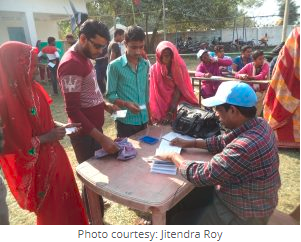Analysis
Fact Sheet: Electoral Violence and Contestation During Nepal’s Second Phase – House of Representative and Provincial Assembly Elections
2017-12-10

House of Representative and Provincial Assembly Elections, Campaign Silence Period & Election Day: Second Phase
December 5 to 7, 2017
On December 7, Nepal concluded the second of two phases of elections to the House of Representatives and provincial assemblies. Voting took place in 45 districts across Nepal with 12,198,852 registered voters eligible to cast their ballots. According to the Election Commission of Nepal, voter turnout was 70 percent. This followed the first phase elections of the House of Representatives and provincial assemblies on November 26 in 32 upper-hill and mountain districts with a voter turnout of 65 percent. First phase ballots were stored and counting only started after second phase polls closed.
The campaign silence period and polling day for the second phase elections, which were held on December 7, were largely peaceful with sporadic incidents of clashes and detonations of improvised explosive devices (IEDs) being reported in several districts across the country.
Nepalmonitor.org recorded 73 election-related incidents (56 violent incidents) that led to the injury of 24 people during the campaign silence period and on the polling day. This compares to 85 incidents (72 violent incidents) and 51 people injured during the same period of the first phase of House of Representatives and Provincial Assembly elections. In the days leading up to the polls, there had been considerable security concerns and the use of IEDs to target senior leaders and disrupt election campaign events intensified following the first phase of polling.
This factsheet provides an overview of election-related incidents that occurred during the campaign silence and polling periods and is based on preliminary data recorded by NepalMonitor.org from 12:00 AM on December 5 until 12:00 PM on December 8.
Background: Nepal’s House of Representatives and Provincial Assembly Elections
On August 21, 2017, the Government of Nepal (GoN) announced that elections to the House of Representatives and provincial assemblies would be held on November 26. On August 30, the GoN revised its decision and announced that elections would be conducted in two phases on November 26 and December 7 due to concerns about logistical management and weather conditions.
These are the first national and provincial elections under the new constitution promulgated on September 20, 2015 and held shortly after the conclusion of the three-phase local elections of May 14, June 28, and September 18. They are also the first elections for the newly created provincial assemblies and an important step to conclude Nepal’s constitutional transition from a Hindu monarchy towards a federal democratic republic.
In the run up to the polls, major political parties worked to form political alliances. On October 3, the Communist Party of Nepal – United Marxist Leninist (CPN-UML) and the Communist Party of Nepal (Maoist Center) [CPN (MC)] announced the formation of a ‘Left Alliance’. In response, Nepali Congress (NC) established the ‘Democratic Electoral Alliance’ on October 4, including Rastriya Prajatantra Party (RPP), and RPP-Nepal. Naya Shakti joined the alliance later. The Madhesi parties, Rastriya Janata Party – Nepal (RJPN), and Federal Socialist Forum Nepal (FSFN) fielded common candidates in the direct elections. In particular, the alliance of CPN-UML and CPN (MC), former rivals on the left, has taken many observers by surprise, and is expected to significantly reshape Nepal’s fragmented political landscape.
The November 26 first phase of elections to the federal parliament and provincial assemblies went largely peacefully, although the use of improvised explosive devices (IEDs) to target senior leaders and campaign events in the days leading up to the polls had created considerable security concerns. In one such incident at least eight people, including a minor, were injured when a bomb blast occurred at an election campaign event of the Left Alliance in Chandrapur Municipality-5, Rautahat on November 17.
The use of IEDs targeting political leaders intensified in the run-up to the second phase polls, with 64 incidents involving IEDs or hoax bombs recorded between November 27 and December 4 (compared to 47 incidents between October 22 and November 23 in the run-up to the first phase). A temporary policeman died a day after he had been injured in a bomb blast targeting Prime Minister Sher Bahadur Deuba’s campaign in Dang on November 28. Several explosions were recorded in the Kathmandu Valley as well. On December 4, former health minister and Nepali Congress candidate for Kathmandu Constituency 4, Gagan Thapa, was among 11 injured when a bomb went off at a campaign event in Chapali Height, Kathmandu.
Although no entity had taken responsibility for specific incidents at the time, a politburo member of Communist Party of Nepal led by Netra Bikram Chand, on December 7, stated that such incidents had been part of the “Cancel the Election Campaign” led by his party.
In response to security concerns, Defence Minister Bhimsen Das Pradhan announced on December 6, that army personnel mobilized for poll security were authorized to shoot people trying to seriously disrupt the December 7 elections, if necessary. Police had also reacted with scores of preventative arrests of people suspected of engagement in anti-election activities. According to the Metropolitan Police Office, about 1,742 preventive arrests were made of suspects for interrogation under the election security plan between November 17th and December 5th in The Kathmandu Valley alone. Preliminary investigations found that 38 of those arrested had been involved in anti-election activities and 588 went on to be charged with various offenses.
To view and download the fact sheet, please click here.

